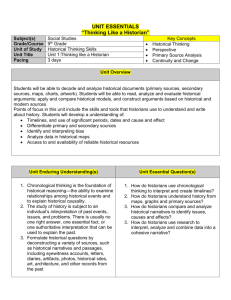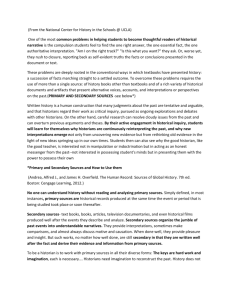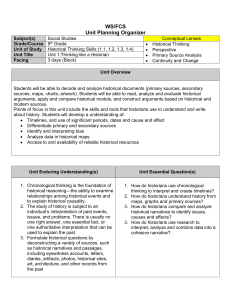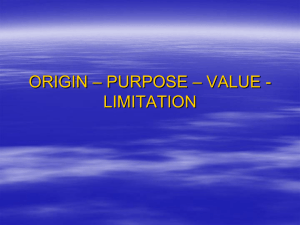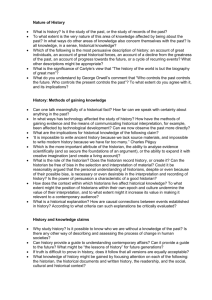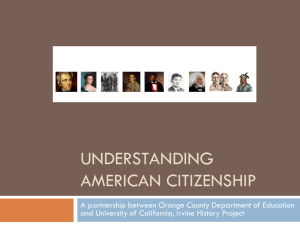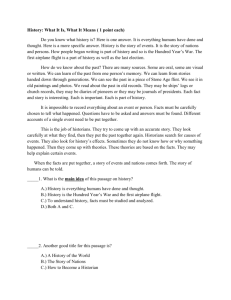Document Interpretation Instructions
advertisement
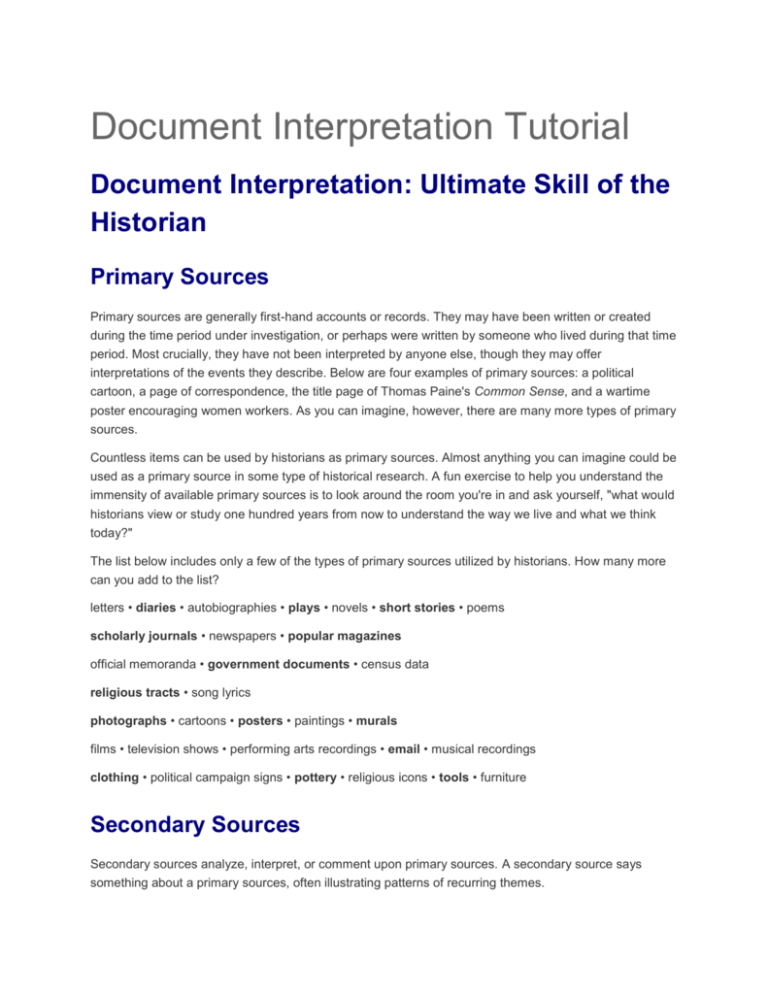
Document Interpretation Tutorial Document Interpretation: Ultimate Skill of the Historian Primary Sources Primary sources are generally first-hand accounts or records. They may have been written or created during the time period under investigation, or perhaps were written by someone who lived during that time period. Most crucially, they have not been interpreted by anyone else, though they may offer interpretations of the events they describe. Below are four examples of primary sources: a political cartoon, a page of correspondence, the title page of Thomas Paine's Common Sense, and a wartime poster encouraging women workers. As you can imagine, however, there are many more types of primary sources. Countless items can be used by historians as primary sources. Almost anything you can imagine could be used as a primary source in some type of historical research. A fun exercise to help you understand the immensity of available primary sources is to look around the room you're in and ask yourself, "what would historians view or study one hundred years from now to understand the way we live and what we think today?" The list below includes only a few of the types of primary sources utilized by historians. How many more can you add to the list? letters • diaries • autobiographies • plays • novels • short stories • poems scholarly journals • newspapers • popular magazines official memoranda • government documents • census data religious tracts • song lyrics photographs • cartoons • posters • paintings • murals films • television shows • performing arts recordings • email • musical recordings clothing • political campaign signs • pottery • religious icons • tools • furniture Secondary Sources Secondary sources analyze, interpret, or comment upon primary sources. A secondary source says something about a primary sources, often illustrating patterns of recurring themes. Perhaps the best example of a secondary source is your textbook. Open it to any chapter and read a couple of paragraphs and you will find that the authors have conducted extensive research utilizing primary sources. They have likely consulted other secondary sources as well. They have then written those paragraphs to explain what they have learned and how they understand the people and ideas of the past. The authors have interpreted the sources for you. The list below includes some of the primary sources we’ve already identified accompanies by secondary sources which might, analyze, interpret, or comment upon them. Primary Source Secondary Sources Abraham Lincoln’s personal letters a biography of Abraham Lincoln A popular magazine from 1910 The 1860 U.S. Federal Census The lyrics “We Shall Overcome” an article about print advertising in the early twentieth century a PowerPoint presentation concerning U.S. population distribution before the Civil War a book examining the Civil Rights movement of the 1960s Grant Woods’ American Gothic an essay on American art and artists An episode of I Love Lucy a made-for-t.v. movie on the life of Lucille Ball A Sioux blanket a photo essay comparing Native American textiles Questions to ask of any source.. 1. Who is the author? Who wrote or created this? Is there a single or multiple authors? An author's identity sometimes helps you answer the later questions. 2. What type of source is this? Is it a photograph or a poem? A biography or a government document? This is a simple but crucial step because you must consider what you can expect to learn from the document. 3. What is the message of this source? What is the author describing? What is happening in the text or image? What is the story? 4. Who is the intended audience? Who is the author addressing? Was the source intended for private or public consumption? Identifying the audience will help you answer the next question. 5. Why was this source created? Does the author have an agenda, a larger purpose? Is the author trying to persuade the audience? Is the document or source simply a compilation of facts, or does it include opinion, inference, or interpretation? 6. Is this source credible and accurate? Historians must examine every source with a critical eye. What do you know about the author? Does the document make sense? Do the facts presented by the author or what you know about the time period support the thesis, statement, assertion, or story the author is conveying? Why should you trust, or distrust, this source? 7. How is this source valuable to me? How does the source relate to other sources from the time period or along the same issue or theme? Does it support or contradict them? Does it repeat information from other sources or add new information? How relevant is the source to your topic of inquiry? Does it extensively cover your topic, or only marginally or not at all? Remember, you should explore enough sources to obtain a variety of viewpoints. In these weekly assignments you will analyze primary sources for yourself, rather than merely reading others' interpretations in secondary sources. When analyzing any primary source, ask yourself seven key questions about the source. In this assignment, you will share your particular interpretation with your group members and comment on their interpretations of the document they chose. MAPS Maps are yet another valuable historical source, and there are many different kinds of maps. Political maps show the names and boundaries of countries, or political units within countries, such as states, counties, or parishes. Physical maps use shades of gray or various colors to illustrate the locations of mountains, valleys, rivers, etc. Topographic maps are similar to physical maps, but use contour lines to show elevation differences, and usually also include locations of rivers, cities, etc. Thematic maps provide information relative to particular topics, such as population or temperature zones. Census maps are a form of thematic map which include not only population distribution, but other details such as age or income. Satellite maps are produced by computers which analyze satellite data. Atlases contain a wealth of information about an area and can combine features of the other maps. Perhaps the most common type of atlas is the road atlas, which focuses on an area’s roadways. Those which were either actually created in the past or modern maps which illustrate historical events, such as a map of Civil War battlefields in the U.S. Identifying the type of map you are using will help you understand what information it can offer. For example, if you wanted to identify the largest U.S. cities in 1920, a satellite map would be of no use. But a census map or political map of 1920 would be very valuable. The Basics Map analysis requires some very basic steps. First, locate the title of the map. Second, locate the scale of the map, which tells you the proportion of the map, generally in miles or kilometers. Third, locate the map’s legend, which explains the meaning of various colors, symbols, or graphic elements used on the map. Seven Questions Once you’ve completed those steps, the seven questions used to analyze primary source documents are also useful in analyzing a map. You will need to determine, if possible: who created the map the type of map what the map is describing the intended audience the reason for its creation the credibility and accuracy of the information the value of the source to your study Details, Details, Details Map analysis is often complex, depending upon the amount of information a map’s creator is attempting to describe. A sharp eye for detail is often your best map analysis tool. It is also important to keep in mind that determining a map’s limitations (what it cannot tell you) is just as important as identifying its purpose (what it can tell you). A Note on Historical Maps Historical maps, specifically those created in the past rather than modern maps which portray the past, have a value beyond the information which they convey. Rare and antique maps are highly valued as art and are appreciated for their beauty. As a result, these maps are often used as primary sources not only to interpret historical events but as part of art history, as well. Document Interpretation One of the most important skills a historian develops is the ability to evaluate historical documents. This evaluation concerns asking questions of the documents that allows a historian to have insight in a particular topic or period being investigated. History is a story. This means that it's not just memorizing dates that matter, but "how those events relate to one another". Historians study sources to reconstruct the life-styles and events of previous generations (what actually happened in the past), as well as to understand the past as the people who lived it did - to examine their ideas and thoughts about the world. By using sources, historians actually create history. They craft an understanding of the people, events, ideas, trends, and themes of the past based upon their interpretation of those sources. Use this activity to learn how to analyze various types of sources and to become an historian yourself. Directions In this weekly interpretation assignment you will need to: 1. Choose one of the documents at the end of the chapter on Mindtap from any category (political, economic and social). 2. Write a 300-500 word interpretation as a group and retell the story in your own words while making connections with the chapter and other course material. You can do this by describing the main characters, the setting and the plot. Make sure you utilize and refer and cite your readings such as Mindtap 14.3. Due by: Tuesday, following week. 3. Write all the group members name on top who contributed. It should be double spaced in New Times Roman Font 12. 4. You have one class session for this and the rest of the time you have to meet outside of class. 5. This is all together worth 5 pts towards your final grade.


